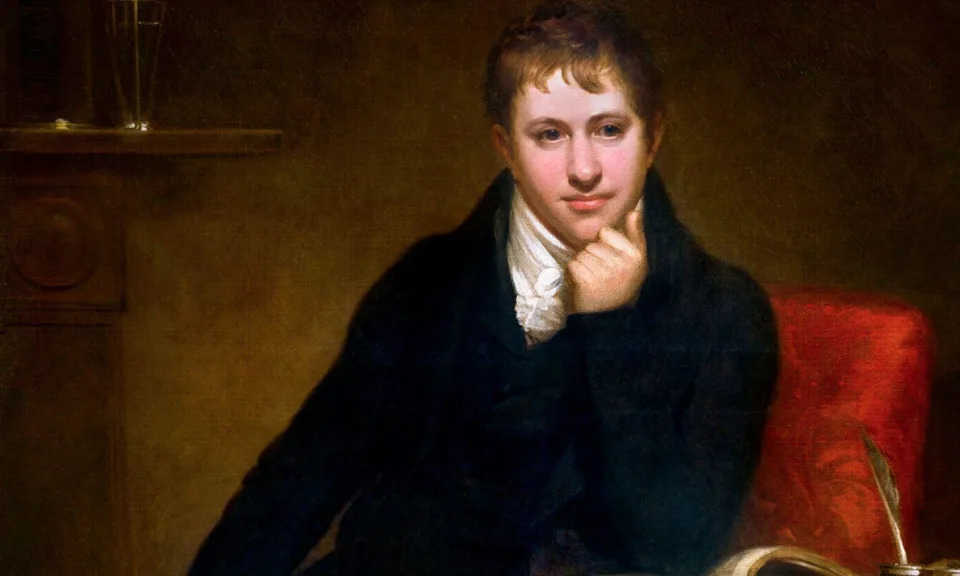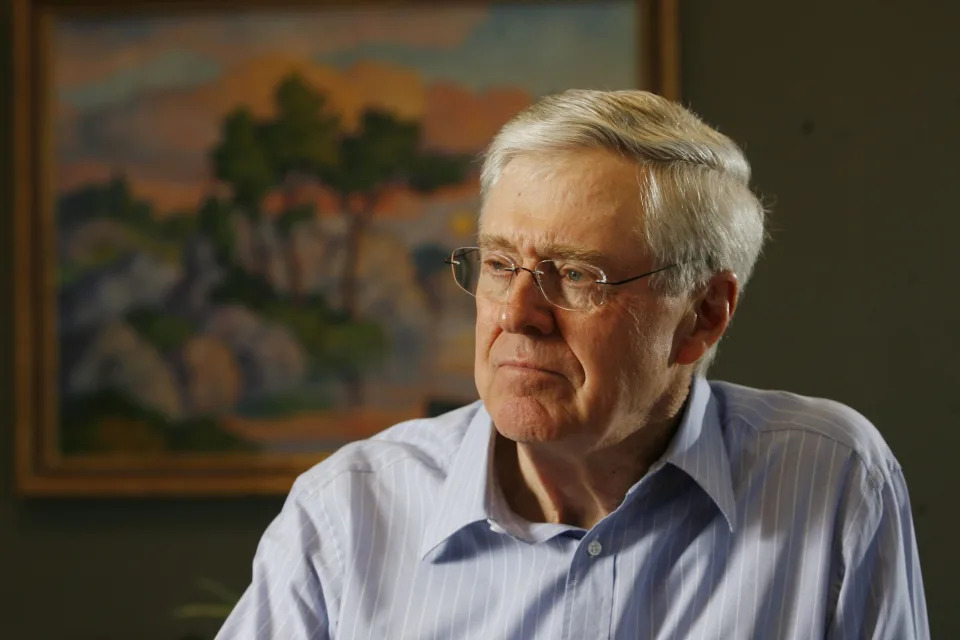Donna Ferguson
Sat, 30 December 2023

Photograph: Alamy
He is famous for discovering elements of the periodic table, for inventing a lamp in 1815 that would save the lives of hundreds of thousands of miners and as an electrochemical pioneer.
But it is the unpublished poetry of the British chemist Sir Humphry Davy – and the intriguing connections between his poems and scientific breakthroughs – that is now electrifying academics.
Researchers at Lancaster University have discovered that Davy secretly penned hundreds of poems in the same notebooks he used to record his groundbreaking electrochemical experiments, discoveries and revelations.
Almost all of these poems – including the one published on Sunday in the Observer for the first time – have never been read before and offer fascinating insights into the inner workings of one of the most extraordinary scientific minds of the 19th century.
“The poetry is just everywhere,” said Sharon Ruston, an English professor at Lancaster University, who, with the help of nine other academics and nearly 3,500 volunteers worldwide, has spent the last four years transcribing 11,417 pages of Davy’s numerous 200-year-old notebooks.
“You do get a real sense of the man himself and his thought processes as he’s working his way through things.”
A friend of Samuel Taylor Coleridge and the poet laureate Robert Southey, Davy was born, said Ruston, “before we had this idea that there was a dividing line between the arts and science”, and only published a few poems in his lifetime, for which he was praised by his famous friends.
But the notebooks reveal that his commitment to his craft was so strong that lines of poetry “jostle for space, sometimes, with accounts of chemical discoveries”, and are found on “pages where you can tell, from the state of the page, that he’s doing chemical experiments”.
These pages, which are torn, burned or have “various stains on them from what he’s working on”, suggest that Davy even wrote poetry in his laboratory, where he pioneered the field of electrolysis.
Ruston said: “He’s writing about nitrous oxide or galvanism. But then there are lines of poetry as well. These two things are happening simultaneously for him. He is trying to figure out what the world is and how to understand the world.”
One of the most exciting finds is a poem Davy wrote about the ruins he saw in Greece and Rome while on a continental tour between 1813 and 1815, which is interspersed with scientific notes about the materials used in the ruins and sculptures.
“This tour is quite an important moment in Davy’s life,” said Ruston.
It was during this tour of Europe with his protege Michael Faraday, who would go on to invent the first electrical generator, that Davy proved the elemental nature of iodine and that diamonds are made of carbon.
She said: “It blew their minds because you start to realise that one substance can have very different forms. So Davy has this real worldview, that there’s nothing in the world that can be created or destroyed. All the matter that we have is all around us, but it’s continually, very slowly changing into new forms.” Ruston sees a “symbiotic relationship” between Davy’s science and his poetry. “They work with each other.”
Related: Sexism in science has roots in Victorian whispering campaigns, claims new book
For example, he would write about the chemical reasons why leaves change colour and then a few pages later compose a poem about the colour of leaves. He was thinking and writing about his ideas, said Ruston, “in both ways: poetry and science. And in his poetry, you can see his scientific knowledge, and in his science you can see poetic language and persuasive rhetoric, and his facility for expressing himself.”
Mark Miodownik, professor of materials and society at University College London, said the discovery of Davy’s poems was significant because it demonstrates that “you can’t be a great scientist and not be a creative person. The idea that the creative industries are solely for the arts and humanities is a modern fallacy.”
Poetry was a private part of Davy’s creative process. “I think he couldn’t help himself. He’s so full of wonder and amazement that he had to do it – things were running around and around in his head and he had to get them out,” said Miodownik.
The notebooks also contain doodle-like sketches of landscapes and faces, and notes about buying candlesticks and other mundane matters. “We’ve got the pages where he actually isolates potassium using electrolysis. But in the middle of that, he mentioned this person and their address,” said Ruston.
Her team discovered it was a reference to a tailor. “We think he was thinking about how he’s going to announce his amazing discovery at the Royal Society and he would need a new suit in order to do that,” she said.
One of the poems found in Davy’s notebooks, published for the first time
Ye grand memorials of the fate of Man;
That rise a moral lesson to our eyes
More strong and more impressive than the lore
Which Sages teach and ponderous tomes enfold.
To raise a temple and to gratify
Imperial pride and luxury. The world
Was ravaged as a million slaves were taught to raise the pole
Fitted for barbarous sports. In which the blood
Of Man was shed. The master of the globe
The image of eternal majesty
Torn by the fangs of the relentless beast
The rack was brought from Egypt.
Ancient Greece was robbed of all her gods
Her temples spoiled.
And the divinities which Phidias framed
Were brought in bondage to the capital
What now remains, pillars & broken shafts
A heap of ruins. Witness those massy walls
Where once a hundred thousand voices hailed
The dying gladiator; silence reigns
And awful solitude – yet a spirit dwells
Within these ruins.
Sexism in science has roots in Victorian whispering campaigns, claims new book
Jealous rivals’ rumours about the supposed effeminacy of popular figures such as Humphry Davy left an enduring legacy, says Dr Heather Ellis
Danuta Kean
THE GUARDIAN
Mon 20 Feb 2017
Jealous rivals’ attempts to destroy 19th-century chemist Sir Humphry Davy’s popularity by insinuating he was gay have left a legacy that means the so-called hard sciences remain a bastion of sexism, a new book claims.
Evidence unearthed by Dr Heather Ellis for her book Masculinity and Science, published by Palgrave, from the archives of the British Science Association, shows that Davy’s popularity created enemies who tried to destroy his reputation. Popular magazines, like the John Bull, launched vicious personal attacks on the chemist’s flamboyant dress and the charismatic delivery at lectures that had brought him a wide female following.
Describing him as the “Professor Brian Cox of his day”, the Sheffield-based academic said: “[Davy’s] lectures were very popular, especially with women and that enhanced his public reputation.”
Rivals also spread rumours of closet homosexuality, speculating on not only his dress, but also his close association with the Romantic poets, especially Southey and Coleridge, with the latter once declaring of Davy: “Had he not been the first chemist, he would have been the first poet of his age.”
“There was a definite attempt to ruin Davy’s career,” Ellis said. “The charges against him tended to reflect his foppish dress, association with aristocrats and that he wrote poetry about the natural world, as well as murmurs that he didn’t have a sexual relationship with his wife.”
One incident in particular was alighted upon as proof of “unmanliness”, Ellis said. On a visit to the Louvre, rivals noted his “apathy” and “total want of feeling” to the Venus de’ Medici, describing his behaviour as “against nature”. They also noted that a statue of Antinous, the male lover of the Roman emperor Hadrian, drew his admiration. “What a strange – what a discordant anomaly in the construction of the human mind do these anecdotes unfold,” the physician John Ayrton Paris declared in a biography of the scientist.
Ellis believes the accusations reflected both Davy’s humble origins as an apothecary’s apprentice in Cornwall and wider social change taking place as the 18th century folded into the 19th. “Davy was a transitional figure,” she added. The rise of a lower-middle-class chemist to the presidency of the aristocratic Royal Society was seen as a threat. “People talked about his elocution and that he ‘smelled of the shop’,” Ellis said.
The backlash against the scientist, who invented the Davy Lamp that saved the lives of miners, was not the only driver for turning science into a stereotypically masculine pursuit during the 19th century. As the century progressed, women were forced out of the laboratory, and eventually the lecture theatre, to fill supportive roles for so-called “men of science”, the historian noted, reflecting a hardening of gender roles throughout wider society.
As well as accusations against Davy, Ellis’s book reveals that rumours swirled around Thomas Huxley and Charles Darwin, although in both cases fingers pointed at their retreat from society and apparent enjoyment of domesticity rather than homosexuality. “Huxley was not helped by the fact that he described science as an escape from the world of men, a world where men cut each other’s throats,” she said.
Ellis believes the move from Enlightenment thinking and social inclusivity in science in the 19th century has had an impact on women in science that resonates today. “We still have the image of the scientist as a male geek or nerd,” she said. “Also, if you look at the scientists who were accused of effeminacy in the 19th century, they were working in the hard sciences, physics and chemistry, in which women remain under-represented. It is a cultural legacy you can link back to then.”
Jealous rivals’ attempts to destroy 19th-century chemist Sir Humphry Davy’s popularity by insinuating he was gay have left a legacy that means the so-called hard sciences remain a bastion of sexism, a new book claims.
Evidence unearthed by Dr Heather Ellis for her book Masculinity and Science, published by Palgrave, from the archives of the British Science Association, shows that Davy’s popularity created enemies who tried to destroy his reputation. Popular magazines, like the John Bull, launched vicious personal attacks on the chemist’s flamboyant dress and the charismatic delivery at lectures that had brought him a wide female following.
Describing him as the “Professor Brian Cox of his day”, the Sheffield-based academic said: “[Davy’s] lectures were very popular, especially with women and that enhanced his public reputation.”
Rivals also spread rumours of closet homosexuality, speculating on not only his dress, but also his close association with the Romantic poets, especially Southey and Coleridge, with the latter once declaring of Davy: “Had he not been the first chemist, he would have been the first poet of his age.”
“There was a definite attempt to ruin Davy’s career,” Ellis said. “The charges against him tended to reflect his foppish dress, association with aristocrats and that he wrote poetry about the natural world, as well as murmurs that he didn’t have a sexual relationship with his wife.”
One incident in particular was alighted upon as proof of “unmanliness”, Ellis said. On a visit to the Louvre, rivals noted his “apathy” and “total want of feeling” to the Venus de’ Medici, describing his behaviour as “against nature”. They also noted that a statue of Antinous, the male lover of the Roman emperor Hadrian, drew his admiration. “What a strange – what a discordant anomaly in the construction of the human mind do these anecdotes unfold,” the physician John Ayrton Paris declared in a biography of the scientist.
Ellis believes the accusations reflected both Davy’s humble origins as an apothecary’s apprentice in Cornwall and wider social change taking place as the 18th century folded into the 19th. “Davy was a transitional figure,” she added. The rise of a lower-middle-class chemist to the presidency of the aristocratic Royal Society was seen as a threat. “People talked about his elocution and that he ‘smelled of the shop’,” Ellis said.
The backlash against the scientist, who invented the Davy Lamp that saved the lives of miners, was not the only driver for turning science into a stereotypically masculine pursuit during the 19th century. As the century progressed, women were forced out of the laboratory, and eventually the lecture theatre, to fill supportive roles for so-called “men of science”, the historian noted, reflecting a hardening of gender roles throughout wider society.
As well as accusations against Davy, Ellis’s book reveals that rumours swirled around Thomas Huxley and Charles Darwin, although in both cases fingers pointed at their retreat from society and apparent enjoyment of domesticity rather than homosexuality. “Huxley was not helped by the fact that he described science as an escape from the world of men, a world where men cut each other’s throats,” she said.
Ellis believes the move from Enlightenment thinking and social inclusivity in science in the 19th century has had an impact on women in science that resonates today. “We still have the image of the scientist as a male geek or nerd,” she said. “Also, if you look at the scientists who were accused of effeminacy in the 19th century, they were working in the hard sciences, physics and chemistry, in which women remain under-represented. It is a cultural legacy you can link back to then.”





No comments:
Post a Comment